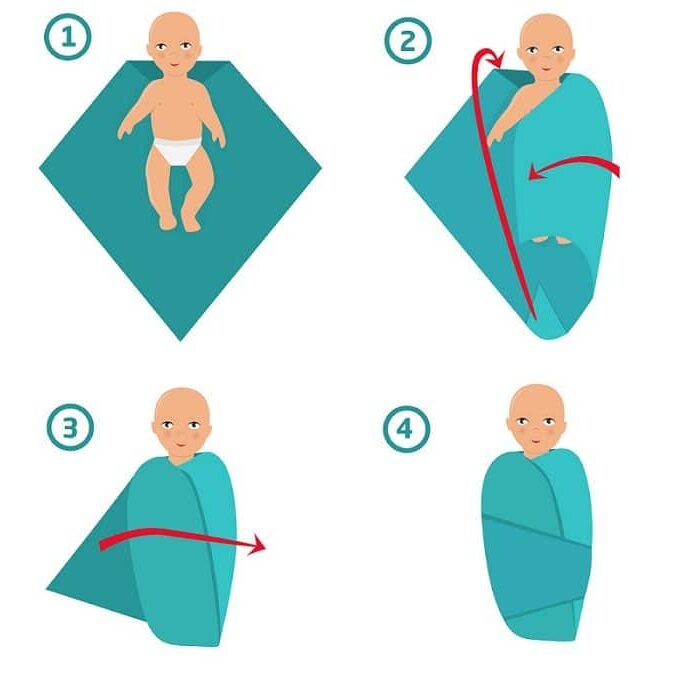Newborn Care and Parenting
Should I Swaddle My Newborn? Is it Helpful? Harmful? Safe?

Babies in tightly wrapped bundles are a common sight on hospital maternity wards. Many parents ask their doula for swaddling instructions upon coming home and hope to learn that tight burrito wrap that the nurses seem to master. But should you learn the swaddling technique, or should you toss out that swaddle blanket?
The swaddle blanket is such a common ritual in parenting that we don’t often think about what we are trying to accomplish by swaddling. As a parent who has swaddled, I found it helpful to understand how it might help me through those early weeks and months. Here is what swaddling does:
Restrains infant movement
The common reasons we hear from caregivers and parents in favor of swaddling include keeping the infant’s hands away from the mouth and face while feeding and controlling the infant’s body and movements. More on this later, and why it might interfere with successful feeding, but yes, a good tight swaddle turns a wiggly newborn into an easily contained bundle!
Keeps babies warm
For the same reasons a “mummy bag” is a warmer solution than a looser sleeping bag, swaddling contains body heat.
Could the swaddle make a baby too warm? Swaddle blankets are to be used with caution. Swaddling, as well as overdressing, can overheat infants and put them at risk for SIDS.
Calms under stress
Swaddling may be a tool for calming a disorganized or fussy infant and can be helpful for infants when sensory overload is setting in (for any baby with a tendency to take too much in.)It has been researched as a stress reducing strategy for infants undergoing painful procedures and has shown some benefit for improved outcomes in premature infants.
Why NOT to swaddle your baby: Unwrapping the controversy
The research showing swaddling’s benefits has, to my knowledge, focused on in-hospital and NICU settings. This makes perfect sense, as the benefit of a swaddle would be to calm the senses and help the infant ‘shut down’ to stimuli. These environments mean round the clock exposure to bright lights, constant activity, sounds of crying infants, beeping machines and painful procedures. We know that ‘hug therapy’, which involves tight pressure against the body, works with children struggling with sensory integration because of autism or other sensory processing disorders. There appears to be some evidence that swaddling can be therapeutic in highly stressful situations or with infants that are experiencing overwhelming stimuli. But, is this the best way for infants to ‘live’ on a regular basis?
Research has been conducted on swaddling infants at risk and on skin to skin contact. When swaddling was compared to skin to skin contact, the infants in skin to skin care showed significantly less stress when exposed to the ‘heel stick’ procedure. More research is emerging that finds there are significant benefits to ‘skin to skin’ when compared with the swaddle as the customary method. There’s both benefit to be found in the skin to skin contact of the unclothed mom/baby but also, the infant who is clothed but still free to move: The ‘unswaddled’ baby.
Touch
Having more surface contact between parent and baby means more gentle sensory stimulation and connection. This kind of touch, and the spontaneous stroking that arises when parents are cuddling their minimally clad infants, increases oxytocin levels in both mothers and infants. This hormone is the calm, connection hormone and facilitates the flow of loving feelings. It also aids in digestion, healing, and learning. Oxytocin is the ‘antidote’ to cortisol, the stress hormone. Research shows that when babies were observed in pediatric appointments one year later, mothers who had early skin to skin contact with their newborns were more snuggly with their babies than those who did not have early skin to skin contact.
Temperature regulation
When premature babies are cared for in kangaroo-care (skin to skin)versus placed under heated bassinetts, their temperature regulation was improved. This ‘regulation’ meant both that baby maintained an optimal overall temperature but also did not have as much contrast between the trunk and extremities. Parents who hold their infants skin to skin keep them in the optimal temperature range, both avoiding the overheating risk of swaddling, but also supporting optimal circulation for their babes.
Recovery, stress & prevention of illness
Skin to skin when compared to swaddling showed a greater benefit for managing pain and for improving blood glucose and cortisol levels, as well as other markers contributing to diminished stress levels in those infants who experienced skin to skin.
Premature and low birth weight infants who received kangaroo-care had improved oxygen saturation, more weight gain, fewer infections, and were discharged earlier. Breastfeeding rates and maternal bonding improved, as well.
Movement
Infants who are unswaddled unquestionably have more freedom of movement. This movement is a form of exercise that improves strength and flexibility through stretching, and it draws out those innate reflexive movements. We are learning more and more about the purpose of these reflexive movements. For instance, those hands in the mouth are hunger driven reflexes, and is one of the cues that help you know that your baby is ready to eat. Those hands might get in the way of the baby latching (one of the reasons mothers go for the swaddle blanket), but they also help organize the baby’s latching behavior when you allow your baby to plant the hands on either side of the breast. So while we’ve been generally ‘fighting’ these hands for the last decades of infant parenting, our babies may be trying to do something of import with those little fists. It turns out they need to use them to communicate to parents that it’s time to eat!
Infant movement allows the infant to take the lead in feeding. Infants feed more effectively when they can go through a sequence of movements, involving their toes to their nose, to locate and grasp the nipple for a successful latch. Swaddled infants are only able to open their mouth, and actually might be restricted in some swaddles from doing that effectively if their shoulders are tightly bound. Infants with skin to skin care on the first day breastfed better and longer than those who were swaddled.
Alternatives to swaddle
Babies do benefit from firm contact and secure holds for soothing. Re-creating a womb environment (Karpman) helps to settle infants. Instead of the swaddle, try the sling! Wearing your baby brings the benefit of closeness, warmth, and reassurance and allows you some hands-free time to move about and get things done! Baby conforms to your body, which is relaxing and encourages a softer tone, while providing that firm pressure that is soothing to jagged nerves.
Finding a balanced approach
Our approach at Birthways is that each family should be supported in finding their own answers. We want to share the research and our experience and explain a bit about what goes into different schools of thought. We can also say from our experience that some infants are swaddled often, some never see a swaddle, and some fall somewhere in the middle–when swaddling is used as a good tool for the disorganized or overwhelmed baby, although hands free works most of the time. It’s common to see families or cultural practices that support one way of doing things, and it’s a joy for us to see how many ‘ways’ there are to have healthy thriving babies and families!
As a parent myself, I had a high tone baby who was difficult to settle. Swaddling was a great tool for napping when my baby became overwhelmed and overstimulated and I wanted to put her down rather than have her in the sling.It was short-lived and occasional, but a helpful tool. For feeding and all other times, she was free to move.
Making swaddling safer
Newborns naturally find a position of flexion, with knees and hips curled in towards the trunk. The swaddle, in its most common but incorrect practice, pulls the body into line and extends arms and legs, preventing the ‘fetal position’ and possibly stressing hips that are best flexed. The best way to swaddle is to allow hands up near the face (elbows bent) and flexed knees and hips and NOT a mummy-like wrap. Pay close attention to overheating, as well.
Ensure that your infant has time to develop his or her strength and range of movement with tummy time and opportunities to spend time in your arms to flex and stretch. Limit the amount of swaddle time. If you are having breastfeeding challenges, skin to skin, baby-led feeds will help your baby learn the ropes. Contact a lactation specialist for further support.



























